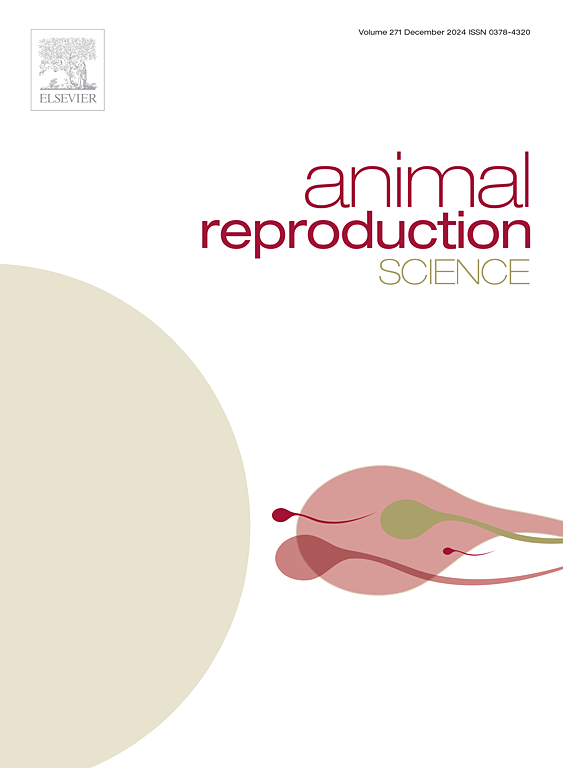常规和缓释GnRH诱导亚洲海鲈产卵的比较效果。
IF 3.3
2区 农林科学
Q1 AGRICULTURE, DAIRY & ANIMAL SCIENCE
引用次数: 0
摘要
本研究旨在通过比较GnRH激素常规释放(R)和缓释(SL)两种释放方式,确定亚洲黑鲈(Lates calcarifer)人工养殖中最有效的激素处理方法。基于saib - pc的SL-GnRH是为持续递送而开发的。20 µg/kg R处理的产卵成功率为100% % (P本文章由计算机程序翻译,如有差异,请以英文原文为准。
Comparative efficacy of regular and slow-release GnRH in inducing spawning in Asian seabass (Lates calcarifer)
This study aimed to identify the most effective hormone treatment for artificial breeding of Asian sea bass (Lates calcarifer) by comparing two delivery methods of GnRH hormone: regular release (R) versus slow-release (SL). SAIB-PC-based SL-GnRH was developed for sustained delivery. The 20 µg/kg R treatment achieved 100 % spawning success (P < 0.05), with 94.4 % fertilization and 95.5 % hatching rates, while 20 µg/kg SL yielded 89.2 % fertilization and 71.4 % buoyant eggs (P < 0.05), indicating prolonged but less synchronized stimulation. Hormonal profiling revealed elevated testosterone and 17β-estradiol (particularly in SL groups) (P < 0.05), with sex-specific cortisol responses (decreased in females, increased in males) (n.s.). Histology confirmed enhanced gametogenesis at 20 µg/kg for both formulations, showing increased mature oocytes and spermatozoa. Metabolic markers (glucose, cholesterol, triglycerides) rose significantly in treated groups (P < 0.05), reflecting reproductive activation. Gene expression analysis demonstrated coordinated gnrh-1 (sharp increase) and kiss2 (gradual rise) transcription patterns, revealing their synergistic regulation of the hypothalamic-pituitary-gonadal axis (P < 0.05). These results establish 20 µg/kg as the optimal dose for both R and SL formulations, with R-GnRH maximizing spawning synchronization and SL-GnRH extending egg production duration (P < 0.05). The study provides the first evidence that SAIB-PC systems can reduce effective GnRH doses by 50–75 % compared to traditional implants while maintaining efficacy. These protocols address critical bottlenecks in seabass aquaculture by improving reproductive outcomes and reducing handling stress, offering practical solutions for hatchery management.
求助全文
通过发布文献求助,成功后即可免费获取论文全文。
去求助
来源期刊

Animal Reproduction Science
农林科学-奶制品与动物科学
CiteScore
4.50
自引率
9.10%
发文量
136
审稿时长
54 days
期刊介绍:
Animal Reproduction Science publishes results from studies relating to reproduction and fertility in animals. This includes both fundamental research and applied studies, including management practices that increase our understanding of the biology and manipulation of reproduction. Manuscripts should go into depth in the mechanisms involved in the research reported, rather than a give a mere description of findings. The focus is on animals that are useful to humans including food- and fibre-producing; companion/recreational; captive; and endangered species including zoo animals, but excluding laboratory animals unless the results of the study provide new information that impacts the basic understanding of the biology or manipulation of reproduction.
The journal''s scope includes the study of reproductive physiology and endocrinology, reproductive cycles, natural and artificial control of reproduction, preservation and use of gametes and embryos, pregnancy and parturition, infertility and sterility, diagnostic and therapeutic techniques.
The Editorial Board of Animal Reproduction Science has decided not to publish papers in which there is an exclusive examination of the in vitro development of oocytes and embryos; however, there will be consideration of papers that include in vitro studies where the source of the oocytes and/or development of the embryos beyond the blastocyst stage is part of the experimental design.
 求助内容:
求助内容: 应助结果提醒方式:
应助结果提醒方式:


